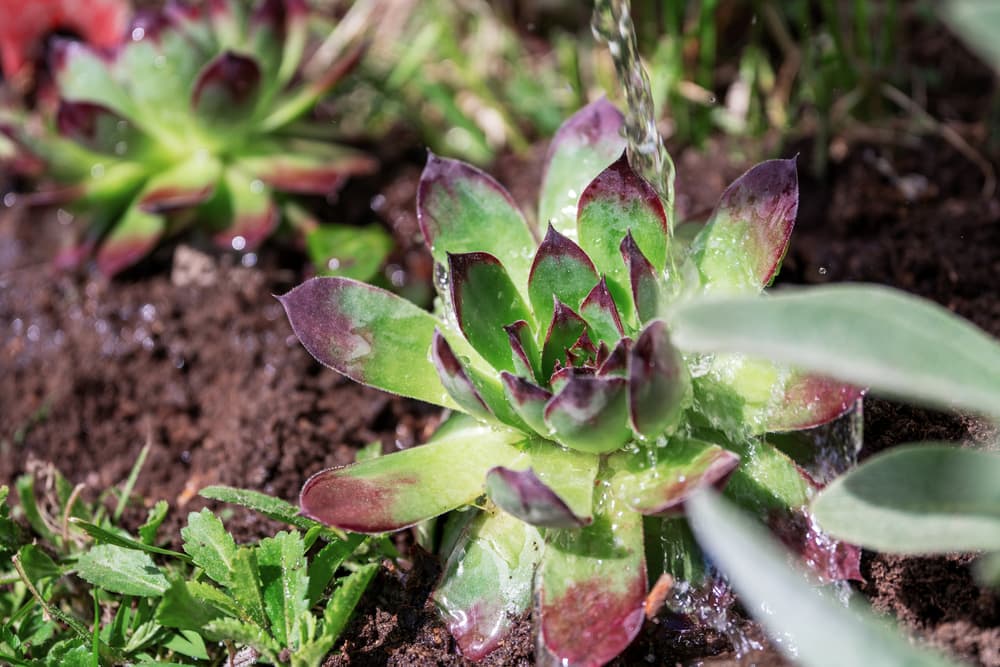SUCCULENTS > SEMPERVIVUM
Chris is a gardening writer and nature enthusiast. He graduated from Oxford Brookes University in 2022 with an MA in Psychology. Chris works with the Leeds Green Action Society, helping their food cooperative by growing various fruit and vegetables on their two allotments in Hyde Park, Leeds.
Reviewed By COLIN SKELLY

Colin is a Horticulturist and Horticultural Consultant with experience in a range of practical and managerial roles across heritage, commercial and public horticulture. He holds the Royal Horticultural Society’s Master of Horticulture award and has a particular interest in horticultural ecology and naturalistic planting for habitat and climate resilience.
Contributions From BECKY SCOTT

Becky Scott is the Co-Owner of the plant nursery Sempervivums By Post, which has been running as a more general plant nursery for 42 years; specialising in Sempervivums since 2018. Becky is also the Director of the not-for-profit organisation, The Wildlife For All Trust.

Tamsin Westhorpe is the Director and Head Gardener at Stockton Bury Gardens, a Judge at the RHS Chelsea Flower Show and a published Author - with 'Diary of a Modern Country Gardener' and 'Grasping the Nettle' amongst her most notable works. Tamsin is also Editor of the HTA magazine 'Inside Horticulture'.
IN THIS GUIDE
SEMPERVIVUM GUIDES
As you might imagine, Sempervivum ‘Houseleek’ has nothing to do with leeks, the vegetables you sometimes use for cooking.
That leek, scientific name Allium porrum, is from the genus of flowering plants that includes shallots, chives, leeks, garlic, onion, and all the other delicious aromatics that are familiar dinner ingredients.
This ‘leek’ on the other hand, is a succulent – one of the colourful, trendy, and easy-to-care-for plants that you see in beautiful little displays like the one below.
In this guide, we’ve worked with Becky Scott, Co-Owner of the plant nursery Sempervivums By Post.
“Sempervivums are great outdoor plants and easy to look after,” says Becky.
“You can grow them in pots, containers, or in the ground in a rockery. The choice of different colours and forms is tremendous.”
If you’re looking for succulents to grow in your home, Sempervivum should be your first port of call.

These stylish and undemanding plants bring flair to even the most mundane living spaces.
You may also see this plant referred to as ‘Hens and Chickens’.
“I love sempervivums and mainly use them as houseplants, but I do put them outside during the summer and they enjoy it,” says Tamsin Westhorpe, a professional Gardener.
“They are great value plants and can be kept in tiny pots.”
Overview
| Botanical Name | Sempervivum |
| Common Name(s) | Houseleek, Hens and Chickens |
| Plant Type | Succulent |
| Native Area | Europe, North Africa, Middle East |
| Hardiness Rating | Mostly H5 – H7 |
| Foliage | Evergreen, fleshy leaved rosettes |
| Flowers | Some pink or pale yellow flowers |
| When To Sow | March, April, May |
| Flowering Months | July, August |
Sunlight
Preferred Sunlight
Full Sun
Exposure
Sheltered
Size
Height
Up to 10cm
Spread
10-50cm
Bloom Time
Summer
Soil
Preferred Soil Type
Loam, Sand
Moisture
Well drained
pH
Any
These plants are evergreen succulents whose name hints at their perennial nature – ‘Sempervivum’ means ‘always alive’ in Latin.1Sempervivum definition and meaning | Collins English Dictionary. (2023). In Collins Dictionaries. Retrieved March 23, 2023, from https://www.collinsdictionary.com/dictionary/english/sempervivum
Its interesting visual characteristics are immediately inviting, and whether you decide to grow Sempervivum outdoors or in a container, you’re guaranteed a good show.
Common Varieties
There are a number of naturally-occurring species and thousands of garden varieties in this family, covering a full rainbow of colour.
There’s no space to introduce all the varieties here, so we’ve chosen a handful that have received the RHS’s Award of Garden Merit.2Ornamental AGM Plants. (2021b, July). Royal Horticultural Society. Retrieved March 23, 2023, from https://www.rhs.org.uk/plants/pdfs/agm-lists/agm-ornamentals.pdf
S. guillaumes

This variety of Sempervivum is a perfect demonstration of the striking form and colour palette you can expect from the plant.
Although colours may vary, they’ll almost always be as vibrant and engaging as the Guillaumes.
The plant is, by nature, mat-forming – that means it spreads out along the ground in dense mats, propagating through ‘offsets’ – nearly-grown plant babies that erupt into growth when they touch ground.
Each spiky cluster is called a ‘rosette’, and the thick, sometimes waxy leaves hold the plant’s water supply; Guillaumes’ rosettes grow about 2cm in diameter.
Like all Sempervivum, Guillaumes are naturally hardy thanks to their rugged North African, Middle Eastern, and Balkan heritage.
S. tectorum

The common houseleek, as this variety is known, has tons of nicknames including ‘Homewort’, ‘Imbroge’, ‘Poor Jan’s Leaf’, ‘Welcome-Home-Husband-However-Drunk-You-Be’ and more.
None of the names give much of a clue about the plant, though.
And none describe its green fading gracefully into deep red, or the attractive clusters of lightly-spiked leaves – nor the complex colour palette that the plant provides year-round.

This is a great little Sempervivum that will make a great impression on any gardener.
It’s just as unfussy as other varieties, but grows slightly larger in size – up to about 10cm.
S. arachnoideum

The boffins amongst you may recognise the ‘arachno’ in this variety’s name as being indicative of spiders.
Don’t worry, though: It’s not named for a tendency to attract these eight-legged critters into your house.
Rather, this houseleek variety is named after its striking cobwebbish aesthetic.
The stringy white hairs at the tip of each head form a web around the spiky leaves, making an unusual and eye-catching visual contribution to any plant container.
Individual rosettes grow to about 3cm across, and like all Sempervivums, this variety is mat-forming.
Expect to see dashes of red year-round, and a bit of pink.
How To Grow Sempervivum
This variety of plant likes full sun, and well-drained soil.
It’s relatively easy to care for in the UK because of its origins in demanding environments.
With Sempervivum, the one thing you want to look out for is overly wet winters.
“If you don’t provide sempervivums with a mix of soil and grit, to provide good drainage, the roots can rot in the winter wet,” explains Becky.

Although this plant can handle a lot, it’ll need a hand being sheltered from the icy blasts we’re prone to get later in the year.
You can either cover the plant or bring it inside for a winter container holiday.
Growing From Seed
You can grow Sempervivum from seed.
To do so, plant them in pots at least 5cm in diameter, push the seed gently below the surface, then leave them to germinate somewhere well-lit and at least 21°C for up to 5 weeks.
If all goes well, you’ll see some germination. In this case, just leave the plant to grow for a while, then move onto the next section.
If all doesn’t go well, which sadly is more likely with Sempervivum from seed, whack the pots in the fridge for a couple of weeks, then take them out and put them back in the well-lit warm spot – hopefully this time around you’ll see germination.

Due to how fiddly and unpredictable this process can be, a lot of people prefer to grow Sempervivum from offsets.
This is essentially cloning the parent plant, and is a much more reliable way to grow houseleek.
“Our advice is don’t grow sempervivums from seed,” says Becky.
“Named varieties are much, much better. They’ve been professionally selected from huge batches of plants grown from seed, usually with specifically chosen parents to give the best chance possible of producing something different.”
“If you’re lucky, one in a thousand plants you grow from seed might be good enough – with the rest below standard.”
Planting Sempervivum
This plant likes a well-drained soil, as we’ve said. Sandy or loamy is best.
“We suggest a mix of John Innes and horticultural grit,” recommends Becky.
It’s not a fussy plant, and will grow well in solitary pots, shared containers, flowerbeds, and even gravelly rock gardens.
“It’s best to grow sempervivums on their own. Select the types you like the look of and mix them up.
“Don’t plant them with other outdoor succulents, such as sedums, because the latter will spread too fast and take over.”

Planting Sempervivums is as simple as filling a container with the right type of soil, placing the plant in the soil, then ensuring the roots are covered.
“Sempervivums spread by offsets, but once a rosette flowers, it will die, which can leave gaps in the planting,” shares Master Horticulturist Colin Skelly.
“Just replant some of the offsets to fill the gaps left.”
You’ll want to compact the earth as well to give the plant a secure footing.
Ongoing Sempervivum Care
Light
Let there be light! Sempervivums love the sunlight, and will do better the more they’re exposed to it.
If you’re planting Sempervivums in your garden, give them pride of place in the brightest spot.
They’ll catch the eye of any visitors, and lend a tremendous visual element to your garden’s aesthetic.
Watering
This plant doesn’t typically need much water.
For the most part, occasional rain should cover your Sempervivum watering needs, but if you’re going through a drought, a light sprinkle every once in a while won’t go amiss.

Check the soil moisture with your finger before watering – a good couple of inches of soil should be mostly dry before you need to add more water.
Common Problems
There are a few pests that enjoy dining out on Sempervivum.
Sempervivum Leaf Miner
This hoverfly larva literally mines the leaves of a Sempervivum plant, to get at the good stuff inside.
You’ll see limp, discoloured leaves, and if you examine more closely, you’ll find small maggots.
To control leaf miner larvae, just pick off and dispose of them when you find them.
Slugs & Snails
Sadly your Sempervivum will find no reprieve from these common garden pests.
Slugs and snails will treat themselves to a little nibble here and a little nibble there, eventually causing massive damage if left unchecked.
To control against slugs and snails, you can make a border of sharded glass, use poisons, or simply remove them manually.
References
- 1Sempervivum definition and meaning | Collins English Dictionary. (2023). In Collins Dictionaries. Retrieved March 23, 2023, from https://www.collinsdictionary.com/dictionary/english/sempervivum
- 2Ornamental AGM Plants. (2021b, July). Royal Horticultural Society. Retrieved March 23, 2023, from https://www.rhs.org.uk/plants/pdfs/agm-lists/agm-ornamentals.pdf

